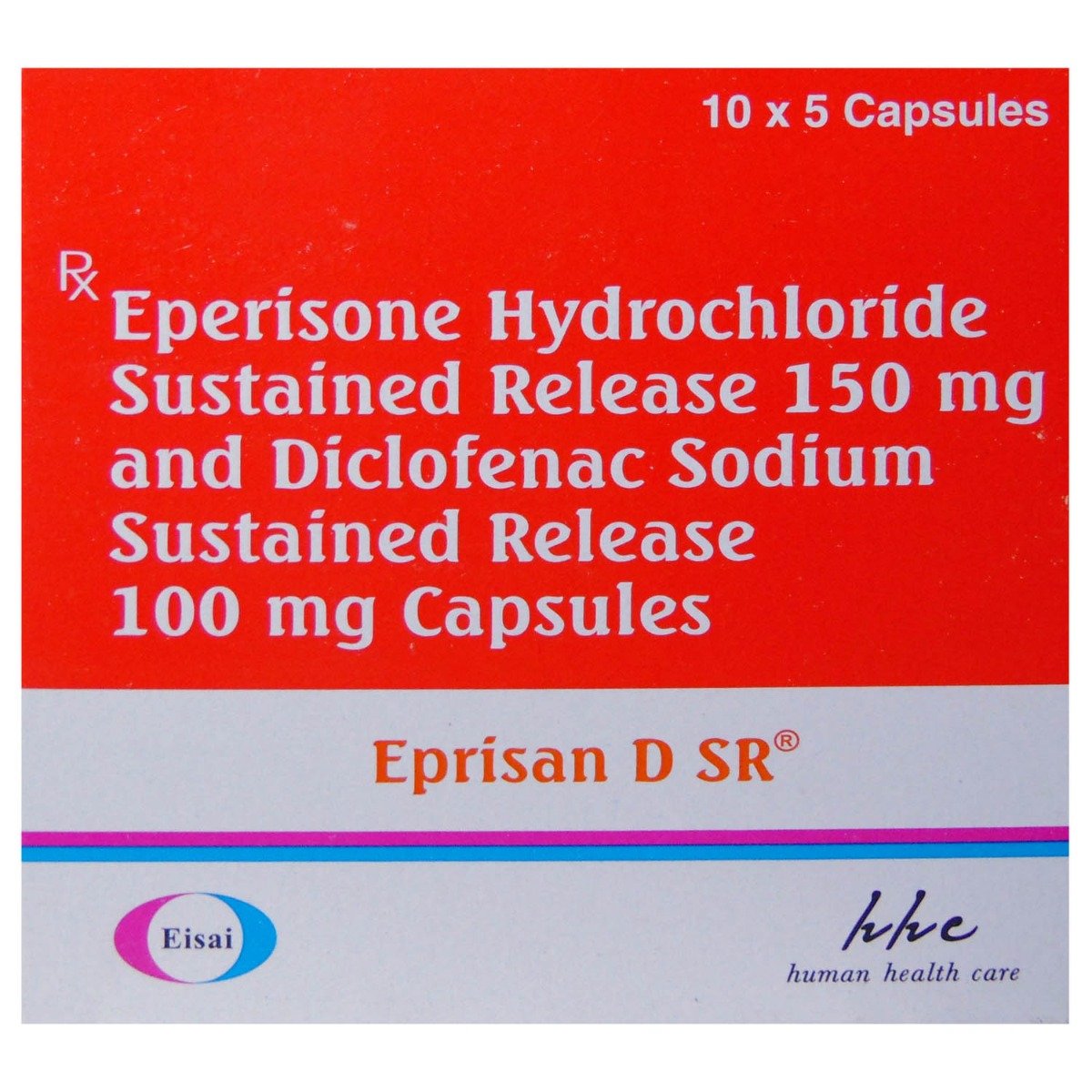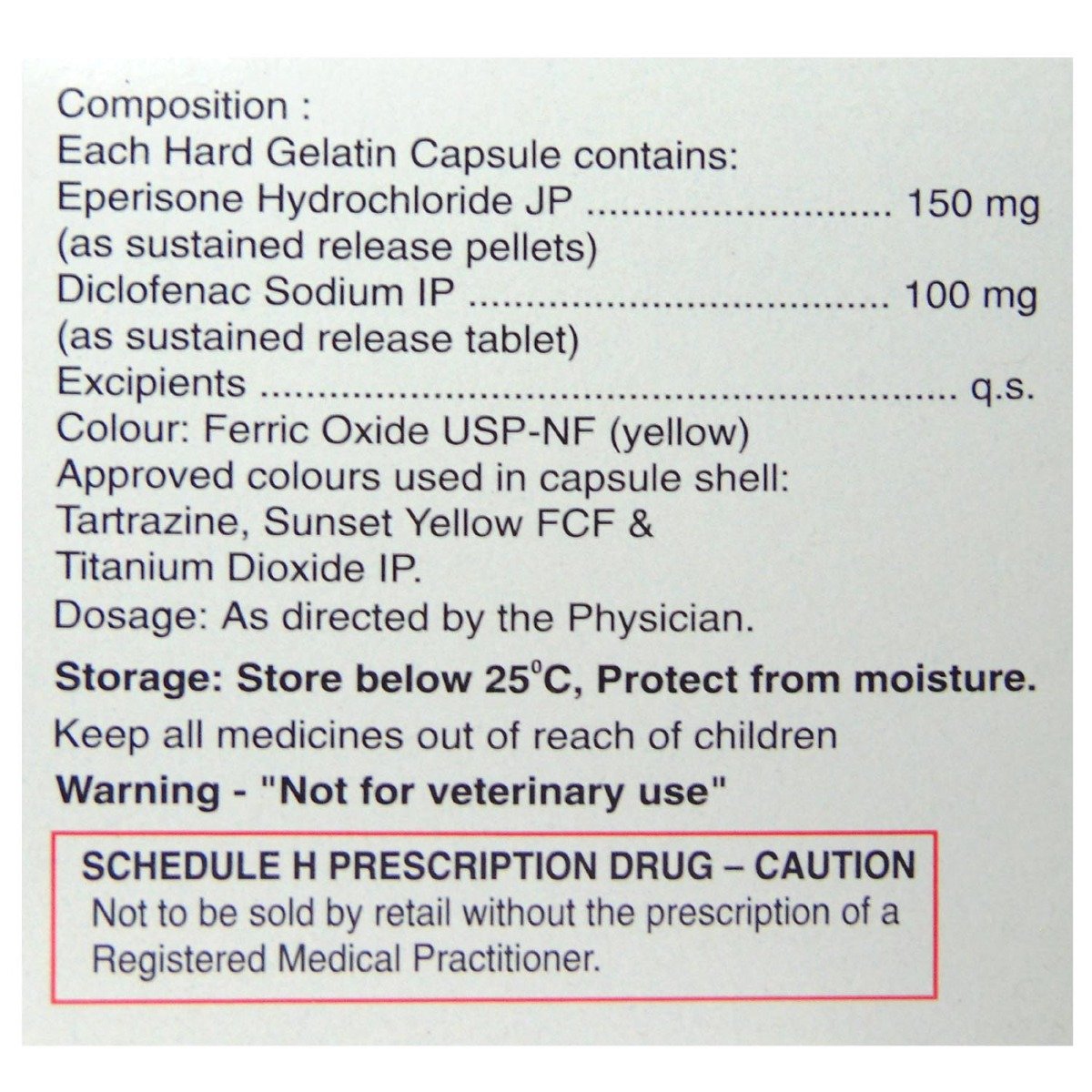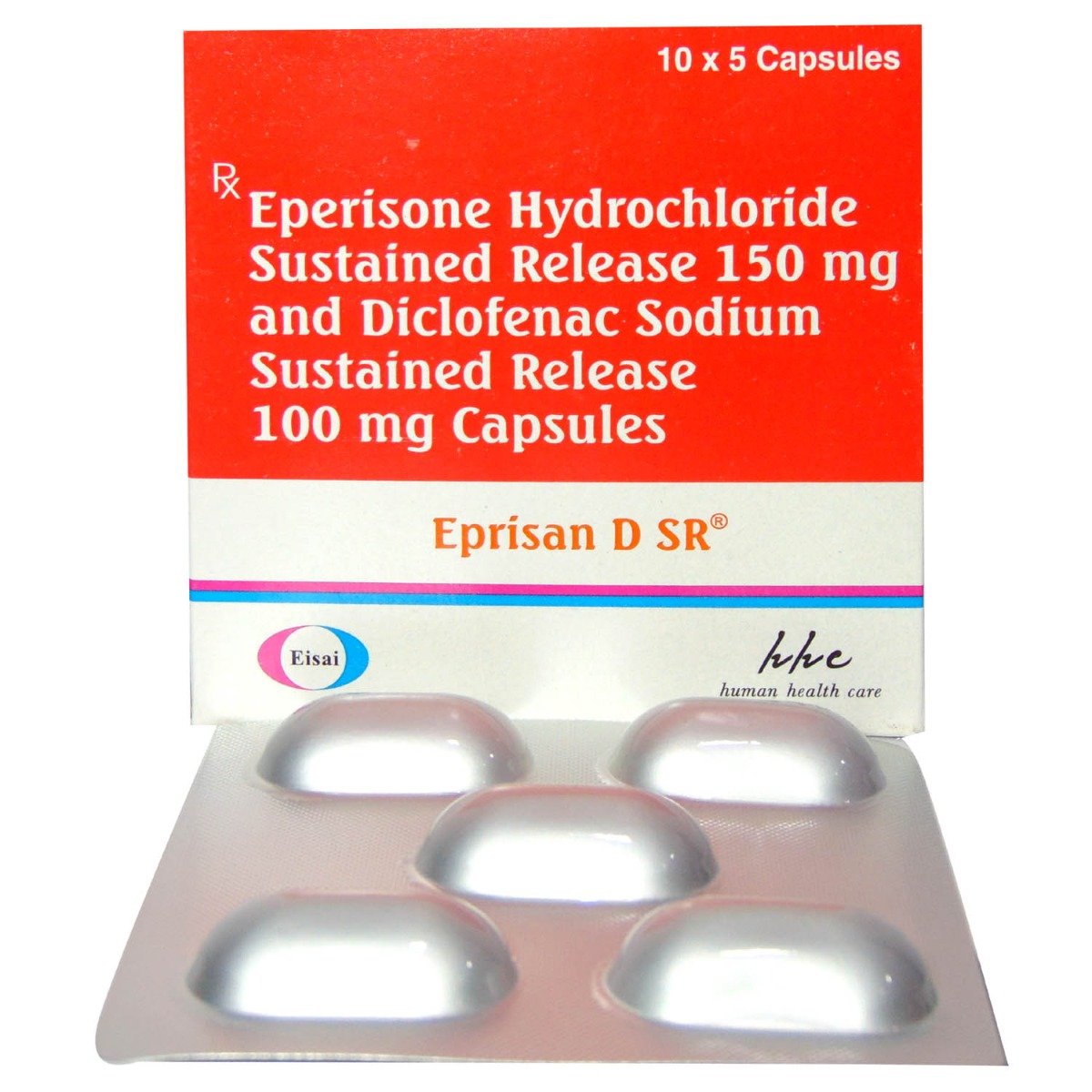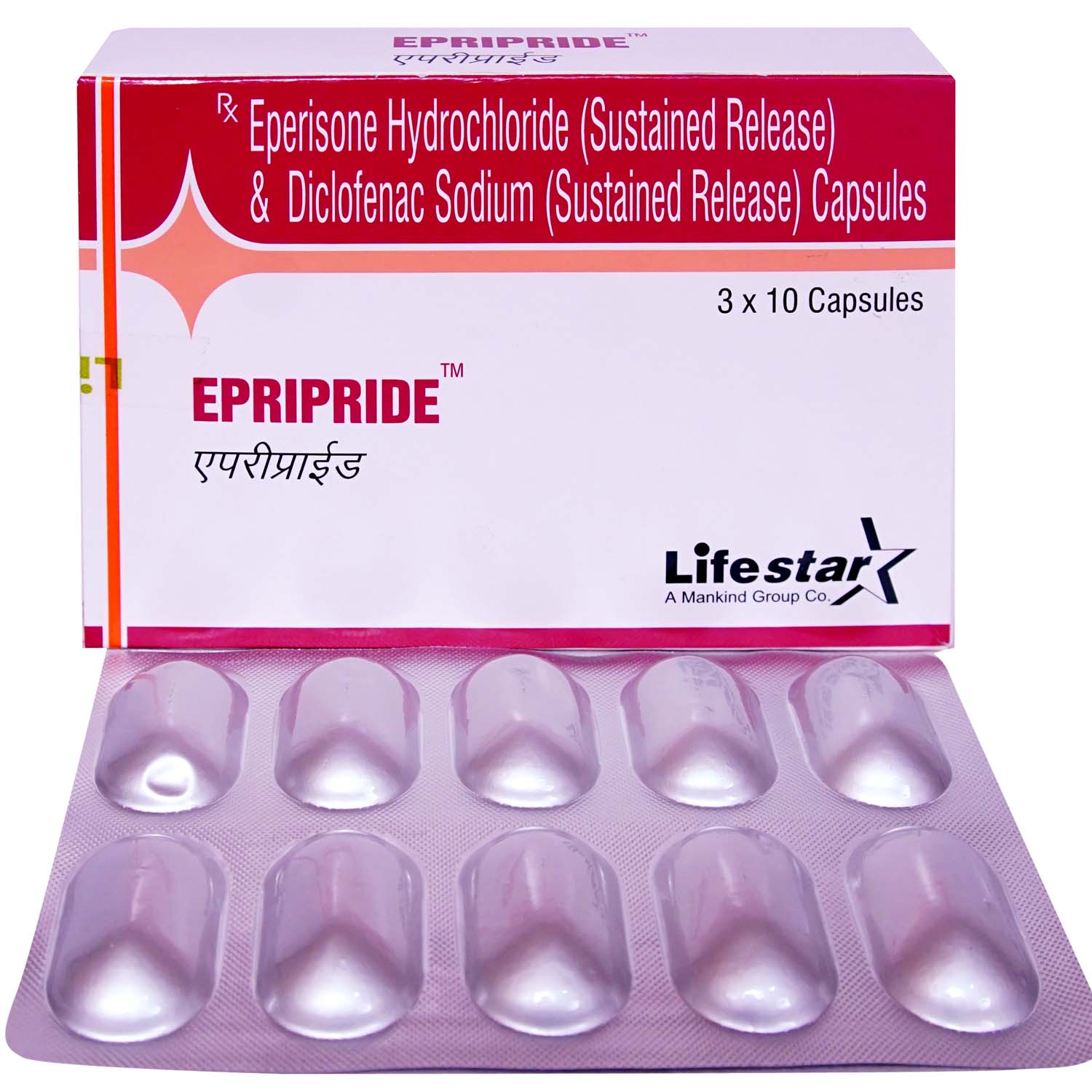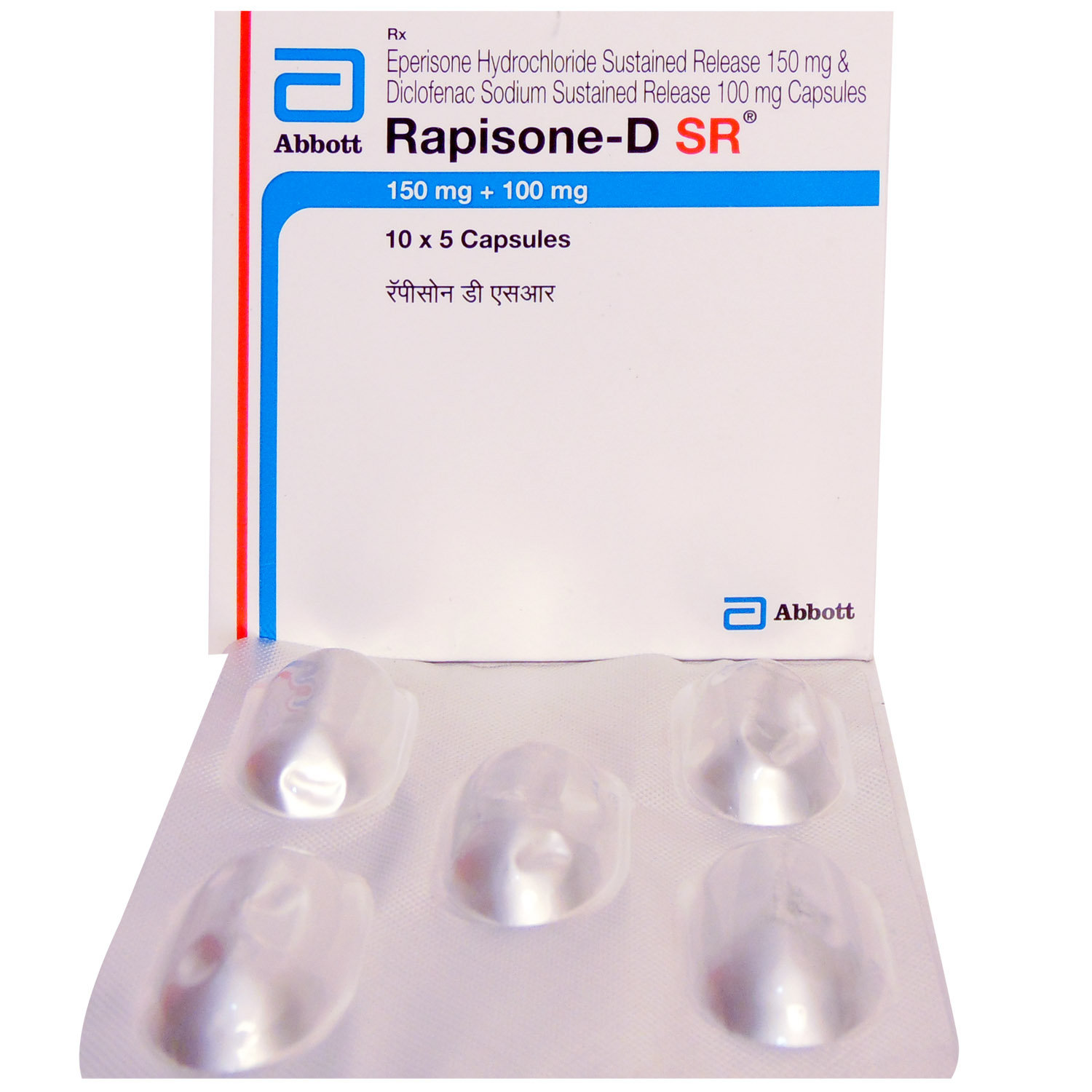Eprisan D SR Capsule 5's
MRP ₹242.5
(Inclusive of all Taxes)
₹36.4 Cashback (15%)
Provide Delivery Location
Online payment accepted
 Prescription drug
Prescription drugWhats That
Composition :
Manufacturer/Marketer :
Consume Type :
Expires on or after :
Return Policy :
About Eprisan D SR Capsule
Eprisan D SR Capsule belongs to the class of ‘analgesics’ used in treating acute musculoskeletal (bone, muscles, or ligaments) spasms associated with low back pain. Low back pain, also called lumbago, is a condition that affects the lower portion of the spine. It often occurs due to injury, strain, or sprain in the muscles, bones, or ligaments present in the lower back. In most cases, the only symptom of this condition is a pain in the lower back.
Eprisan D SR Capsule contains Eperisone and Diclofenac. Eperisone is an antispasmodic. It works by relaxing skeletal muscles and reducing myotonia (inability of muscles to relax). It can relax vascular smooth muscles (present in the blood vessels wall) to improve blood circulation. It can also suppress pain reflex. Diclofenac is a nonsteroidal anti-inflammatory drug (NSAID). It works by reducing prostaglandins' production (chemical substances that cause pain and inflammation) at the affected site (muscle) and reduce pain.
You should use this medicine exactly as prescribed by the doctor. The common side-effects of Eprisan D SR Capsule are nausea, vomiting, stomach pain, heartburn, diarrhoea, indigestion, flatulence (gas), loss of appetite, headache, weakness, drowsiness, dizziness, and skin rash or spots. These side-effects are usually mild and temporary. However, if any of these side-effects persist or get worse, inform your doctor immediately.
It is not recommended to take Eprisan D SR Capsule if you are allergic to any contents of it. Before taking Eprisan D SR Capsule, inform your doctor if you have bleeding or ulcer in the stomach, history of stomach or bowel problems with NSAIDs, severe liver, kidney, heart failure, history of heart attack or stroke, and problems blood circulation. It is not recommended in children, pregnant women, and breastfeeding mothers. It should be used with caution in elderly patients. Avoid consumption of alcohol as it may increase the risk of side-effects. Eprisan D SR Capsule may cause dizziness or drowsiness, so do not drive or operate heavy machinery if you are not fully alert.
Uses of Eprisan D SR Capsule
Directions for Use
Key Benefits
Eprisan D SR Capsule is used to treat pain associated with muscle spasms that usually occur due to muscle strains, sprains, or injuries in the lower back. It contains eperisone and diclofenac. Eperisone is a muscle relaxant that shows an analgesic effect (relieve pain), whereas diclofenac can reduce pain, swelling, and inflammation in the muscles. It provides fast relief from pain, within a few hours after taking this medicine. It reduces muscle stiffness and enables the easy movement of the muscle. It is also well tolerated when taken at recommended doses. For the best results, rest and physical therapy are also essential along with this medicine.
Storage
- Rash caused by allergies is due to irritants or allergens. Therefore, avoid contact with such irritants.
- Consult your doctor for proper medication and apply an anti-itch medication. Follow the schedule and use the medication whenever needed.
- Protect your skin from extreme heat and try to apply wet compresses.
- Soak in the cool bath, which gives a soothing impact to the affected area.
- Report the itching to your doctor immediately; they may need to change your medication or dosage.
- Use a cool, damp cloth on the itchy area to help soothe and calm the skin, reducing itching and inflammation.
- Keep your skin hydrated and healthy with gentle, fragrance-free moisturizers.
- Try not to scratch, as this can worsen the itching and irritate your skin.
- If your doctor prescribes, you can take oral medications or apply topical creams or ointments to help relieve itching.
- Track your itching symptoms and follow your doctor's guidance to adjust your treatment plan if needed. If the itching persists, consult your doctor for further advice.
- Prepare for a restful night's sleep: Develop a calming pre-sleep routine, like reading or meditation, to help your body relax and prepare for sleep.
- Create a sleep-conducive Environment: Make bedroom a sleep haven by ensuring it is quiet, dark and calm.
- Follow a Sleep Schedule: Go to bed and get up at the same time every day to help regulate your body's internal clock and increase sleep quality.
- Try relaxing techniques like deep breathing, mindfulness meditation and any others.
- Limit stimulating activities before bedtime: Avoid stimulating activities before bedtime to improve sleep quality.
- Monitor Progress: Keep track of your sleep patterns to identify areas for improvement.
- Consult a doctor if needed: If these steps don't improve your sleep, consult a doctor for further guidance and therapy.
- Hydrate your body: Drink enough water to prevent dehydration and headaches.
- Calm Your Mind: Deep breathing and meditation can help you relax and relieve stress.
- Rest and Recharge: Sleep for 7-8 hours to reduce headache triggers.
- Take rest: lie down in a quiet, dark environment.
- Cold or warm compresses can help reduce tension.
- Stay Upright: Maintain good posture to keep symptoms from getting worse.
- To treat headaches naturally, try acupuncture or massage therapy.
- Over-the-counter pain relievers include acetaminophen and ibuprofen.
- Prescription Assistance: Speak with your doctor about more substantial drug alternatives.
- Severe Headaches: Seek emergency medical assistance for sudden, severe headaches.
- Frequent Headaches: If you get reoccurring headaches, consult your doctor.
- Headaches with Symptoms: Seek medical attention if your headaches include fever, disorientation, or weakness.
- Inform your doctor about the nausea and discuss possible alternatives to the medication or adjustments to the dosage.
- Divide your daily food intake into smaller, more frequent meals to reduce nausea.
- Opt for bland, easily digestible foods like crackers, toast, plain rice, bananas, and applesauce.
- Avoid certain foods that can trigger nausea, such as fatty, greasy, spicy, and smelly foods.
- Drink plenty of fluids, such as water, clear broth, or electrolyte-rich beverages like coconut water or sports drinks.
- Use ginger (tea, ale, or candies) to help relieve nausea.
- Get adequate rest and also avoid strenuous activities that can worsen nausea.
- Talk to your doctor about taking anti-nausea medication if your nausea is severe.
- Record when your nausea occurs, what triggers it, and what provides relief to help you identify patterns and manage your symptoms more effectively.
Drug Warnings
Before taking Eprisan D SR Capsule, inform your doctor if you have any bowel disorders such as colitis (inflammation of the intestine), kidney or liver problems, porphyria (inherited blood disorder), bleeding disorders, asthma, seasonal allergies, long-term respiratory infections or illnesses, angina (chest pain), blood clots, high blood pressure, high cholesterol, diabetes, systemic lupus erythematosus (a skin disorder), smoking habit, and intolerance to some sugars. Eprisan D SR Capsule increases the risk of heart attack or stroke if high doses are used for prolonged periods. So, use it in the dose and duration as prescribed by the doctor. If you notice chest pain, breathing difficulties, weakness, or slurry speech, inform your doctor immediately as it can be a sign of problems with heart or blood vessels. Eprisan D SR Capsule is an anti-inflammatory and can mask the symptoms of an infection, so consult your doctor if you feel unwell.
Drug-Drug Interactions
Drug-Drug Interactions
Login/Sign Up
Co-administration of Eprisan D SR Capsule with Meloxicam can increase the risk or severity of gastrointestinal side effects.
How to manage the interaction:
Taking Meloxicam with Eprisan D SR Capsule is not recommended as it can possibly result in an interaction, it can be taken if your doctor has advised it. However, consult your doctor immediately if you experience symptoms such as dizziness, lightheadedness, red or black, tarry stools, coughing up or vomiting fresh or dried blood that looks like coffee grounds, severe headache, and weakness. Do not stop any medication without doctor's advise.
Taking Eprisan D SR Capsule with Enoxaparin can increase the risk of bleeding complications.
How to manage the interaction:
There may be a possible interaction between Eprisan D SR Capsule and Enoxaparin, but they can be taken together if your doctor has prescribed them. However, consult your doctor immediately if you experience any unusual bleeding or bruising, swelling, vomiting, blood in your urine or stools, headache, dizziness, or weakness. Do not discontinue any medications without consulting a doctor.
Coadministration of Eprisan D SR Capsule with Ketoconazole may increase the risk of liver problems.
How to manage the interaction:
There may be a possible interaction between Eprisan D SR Capsule and Ketoconazole, but they can be taken together if a doctor has prescribed them. However, consult a doctor immediately if you have fever, chills, joint pain or swelling, unusual bleeding or bruising, skin rash, itching, loss of appetite, fatigue, nausea, vomiting, abdominal pain, dark colored urine, light colored stools, and/or yellowing of the skin or eyes. Do not discontinue any medications without consulting a doctor.
Taking Eprisan D SR Capsule with human immunoglobulin may increase the risk of kidney problems.
How to manage the interaction:
Although there is an interaction between Human immunoglobulin and Eprisan D SR Capsule, you can take these medicines together if prescribed by a doctor. However, consult the doctor immediately if you experience symptoms such as nausea, vomiting, loss of appetite, increased or decreased urination, sudden weight gain or weight loss, fluid retention, swelling, shortness of breath, muscle cramps, tiredness, weakness, dizziness, confusion, and irregular heart rhythm. Do not discontinue any medications without consulting a doctor.
Taking Eprisan D SR Capsule with Ibrutinib can increase the risk of bleeding tendencies.
How to manage the interaction:
There may be a possible interaction between Eprisan D SR Capsule and Ibrutinib, but they can be taken together if a doctor has prescribed them. However, consult a doctor immediately if you experience any unusual bleeding, dizziness, lightheadedness, red or black, tarry stools, coughing up or vomiting fresh or dried blood that looks like coffee grounds, or severe headaches. Do not discontinue any medications without consulting a doctor.
Co-administration of Eprisan D SR Capsule with Celecoxib may increase the risk of stomach bleeding and ulcers.
How to manage the interaction:
Although there is a interaction between Eprisan D SR Capsule and Celecoxib, but it can be taken if your doctor has advised it. Consult a doctor if you experience symptoms like blood in your urine or stool (or a black stool), severe bruising, prolonged nosebleeds, feeling dizzy or lightheaded, weakness or severe headache, vomiting blood or coughing up blood, heavy menstrual bleeding (in women), difficulty breathing, or chest pain. Do not discontinue any medication without consulting a doctor.
Co administration of Eprisan D SR Capsule with Leflunomide may result in liver problems.
How to manage the interaction:
Co-administration of Eprisan D SR Capsule and Leflunomide can lead to an interaction; it can be taken if advised by your doctor. However, if you have a fever, chills, joint pain or swelling, unusual bleeding or bruising, skin rash, itching, loss of appetite, fatigue, nausea, vomiting, abdominal pain, dark-colored urine, light-colored stools, or yellowing of the skin or eyes. Do not stop using any medication without consulting your doctor.
Concomitant administration of Eprisan D SR Capsule and furosemide may decrease the therapeutic efficacy of furosemide and adversely affect renal function.
How to manage the interaction:
There may be a possible interaction between Eprisan D SR Capsule and furosemide, but they can be taken together if your doctor has prescribed them. However, consult your doctor immediately if you experience symptoms like nausea, dizziness, irregular heartbeats, altered blood pressure, tingling. Do not stop using any medications without first talking to your doctor.
Co-administration of Eprisan D SR Capsule and tenofovir alafenamide may cause kidney problems.
How to manage the interaction:
There may be a possible interaction between Eprisan D SR Capsule and Tenofovir alafenamide but they can be taken together if your doctor has prescribed them. However, consult your doctor immediately if you experience symptoms such as such as nausea, vomiting, loss of appetite, increased or decreased urination, sudden weight gain or weight loss, fluid retention, swelling, shortness of breath, bone pain, muscle cramps, tiredness, weakness, dizziness, confusion, and irregular heart rhythm. Do not stop using any medications without talking to your doctor.
Taking Dasatinib together with Eprisan D SR Capsule may increase the risk of bleeding.
How to manage the interaction:
There may be a possible interaction between Eprisan D SR Capsule and Dasatinib but they can be taken together if a doctor has prescribed them. However, consult a doctor immediately if you experience dizziness, red or black, tarry stools, or severe headaches. Do not discontinue any medications without consulting a doctor.
Drug-Food Interactions
Drug-Food Interactions
Login/Sign Up
Diet & Lifestyle Advise
- Exercising regularly helps in muscle stretching so that they are less likely to spasm, tear, and sprain. Mild exercises such as jogging and walking are helpful for muscle stretching.
- Deep tissue massages with the help of muscle massager are considered helpful.
- Avoid wearing tight-fitting clothes, instead, wear loose garments.
- Rest well and get optimal sleep (at least 8 hours for adults).
- Hot or cold therapy can help treat muscle spasms.
- Apply an ice-pack or hot-pack on the muscle for 15-20 minutes.
- Try to include glycine (protein) in your daily diet, which is good food for your muscle.
Side Effects of Eprisan D SR Capsule
- Nausea
- Vomiting
- Stomach pain
- Heartburn
- Diarrhoea
- Indigestion
- Flatulence (gas)
- Loss of appetite
- Headache
- Weakness
- Drowsiness
- Dizziness
- Skin rash or spots
Habit Forming
Therapeutic Class
All Substitutes & Brand Comparisons
RX
Out of StockEpripride Capsule 10's
Mankind Pharma Pvt Ltd
₹121
(₹10.89 per unit)
75% CHEAPERRX
Myoset D Capsule 10's
Sparsh Remedies Pvt Ltd
₹242.5
(₹21.34 per unit)
51% CHEAPERRX
Eperifen Capsule 10's
Tas Med India Pvt Ltd
₹274
(₹24.66 per unit)
43% CHEAPER
Drug-Diseases Interactions
Drug-Diseases Interactions
Login/Sign Up
FAQs
Drug-Drug Interactions Checker List
- WARFARIN
- LITHIUM
- METHOTREXATE
- TACROLIMUS
- CICLOSPORIN
- TRIMETHOPRIM
- ASPIRIN
- IBUPROFEN
- MIFEPRISTONE
- DIGOXIN
- VORICONAZOLE
- PHENYTOIN
- COLESTIPOL
- CHOLESTYRAMINE
- METHOCARBAMOL
Special Advise
- Your doctor may advise you to undergo regular blood tests to monitor liver function while using Eprisan D SR Capsule if it is prescribed for longer durations.
- Take Eprisan D SR Capsule with food to minimize side-effects associated with stomach and intestine such as diarrhoea/upset stomach.
Disease/Condition Glossary
Low back pain: It is also called lumbago. It is a common condition that occurs due to injury, sprain, or strain to the muscles, bones, or ligaments present in the lower portion of the spine. The common causes are lack of regular exercise, improper postural lifting, bad or poor posture, and fracture. Pain in the lower back is the only symptom often seen with this condition. Analgesics (pain relievers) and physical therapy can help to relieve pain. Exercise helps in muscle stretching so that they are less likely to spasm, tear and sprain.

Have a query?
Alcohol
Safe if prescribed
Consumption of alcohol increases the risk of side-effects, such as liver damage and bleeding in the stomach.
Pregnancy
Consult your doctor
Eprisan D SR Capsule is usually not recommended during pregnancy, especially if you are more than six months pregnant as it may cause harmful effects to the unborn baby.
Breast Feeding
Consult your doctor
Eprisan D SR Capsule may pass into breastmilk and cause unwanted effects in the nursing baby. So, it is not prescribed in breastfeeding mothers. However, if prescribed, the doctor may advise you to stop breastfeeding while using this medicine.
Driving
Safe if prescribed
Eprisan D SR Capsule may cause dizziness or drowsiness, so do not drive or operate heavy machinery if you are not fully alert.
Liver
Consult your doctor
Eprisan D SR Capsule causes liver damage, so it should be used with caution in patients with liver diseases. The dose may have to be adjusted by your doctor.
Kidney
Consult your doctor
Eprisan D SR Capsule should be used with caution in patients with kidney diseases. The dose may have to be adjusted by your doctor.
Children
Safe if prescribed
Eprisan D SR Capsule is not recommended for children below 12 years of age.

